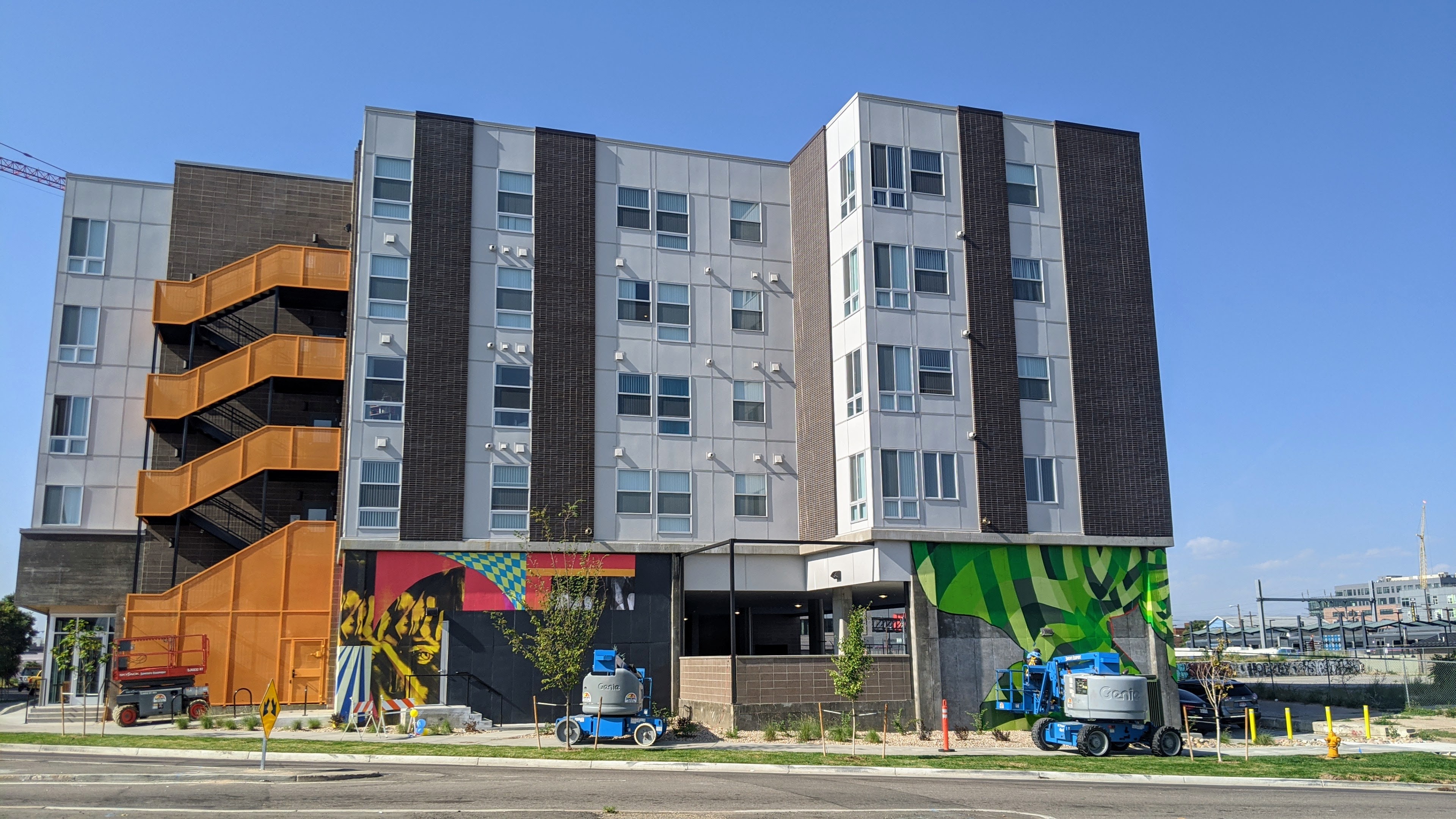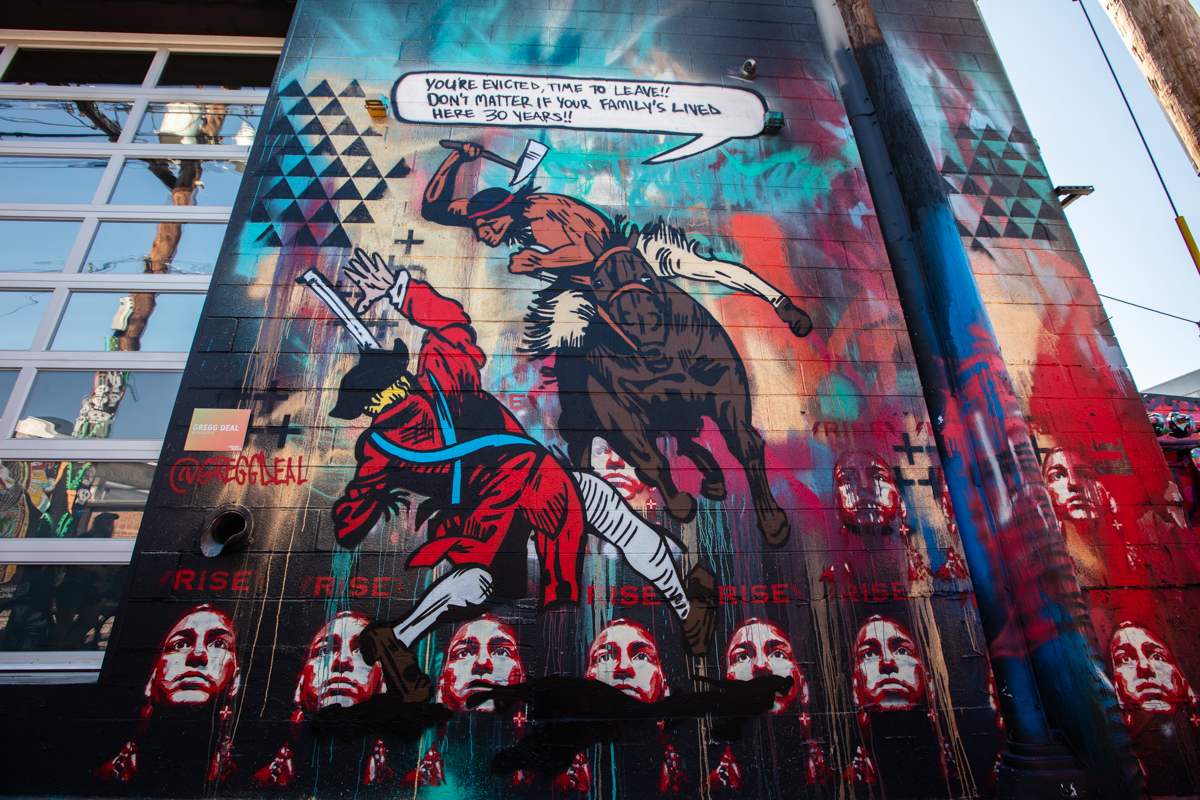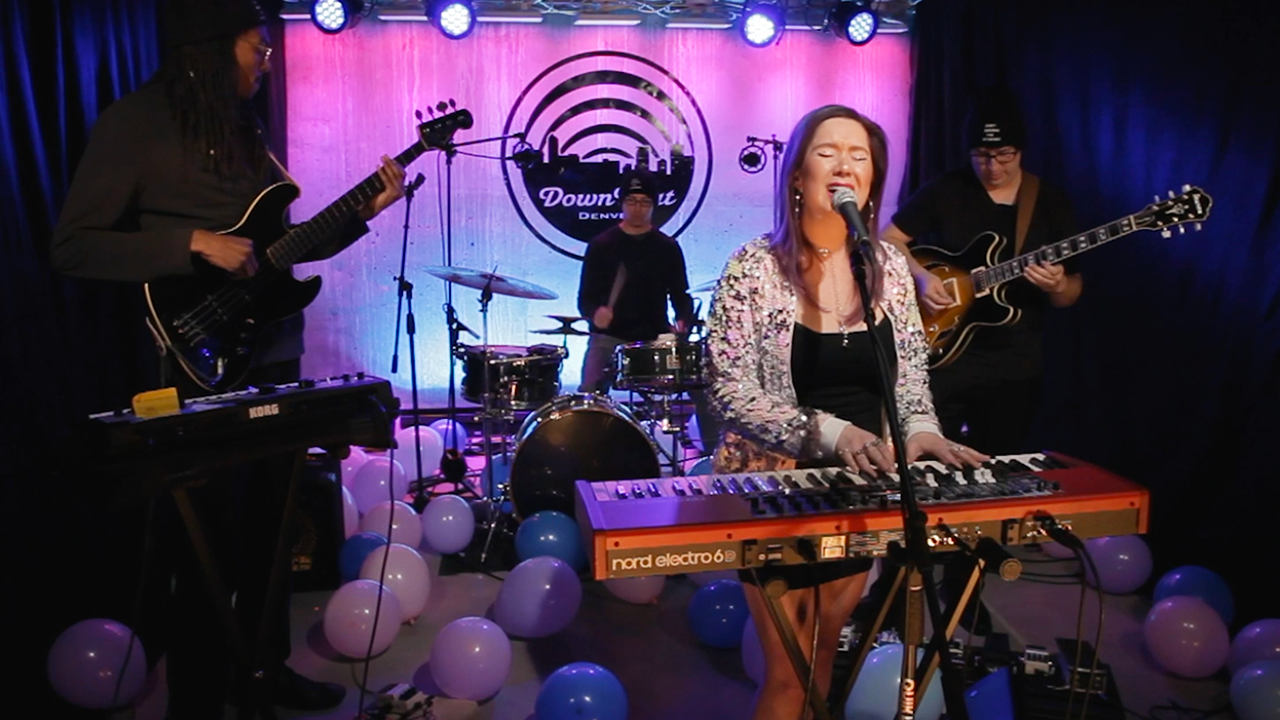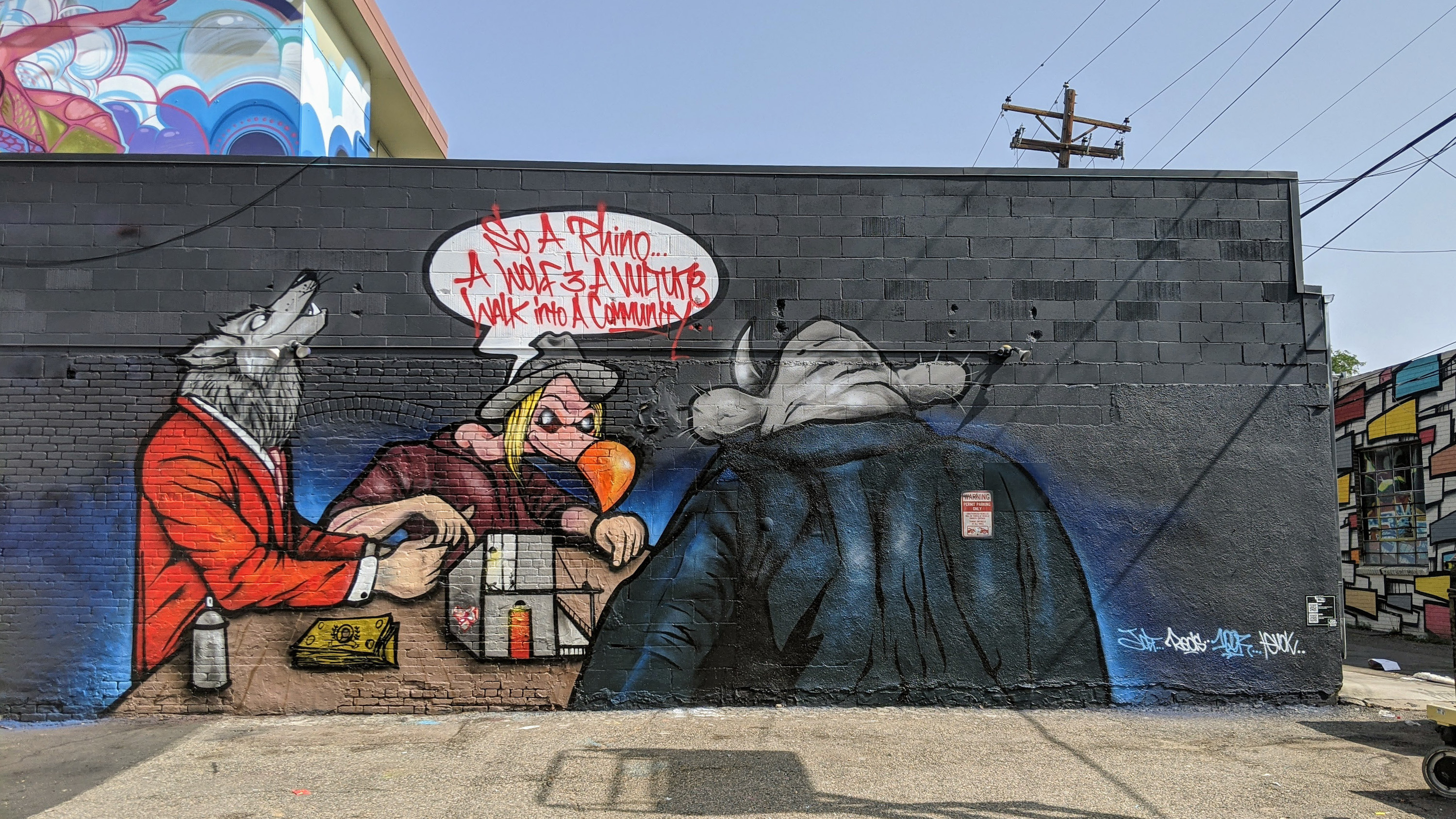For the last few years, the street art festival CRUSH has been edging toward a more organized, consistent and marketable event, but this year it finally matured into a new, and perhaps troubling, form. Where the last few years felt like an awkward pre-teen stage, this year felt like full-on adolescence — more self-aware but not yet capable of seeing the big picture or understanding its own role in a gentrified neighborhood.
Some might say that CRUSH has grown into the festival it deserves to be — securing high-profile artists, attracting large crowds of onlookers, bringing money to local businesses, making blank walls into monumental artworks. And while all of those aspects of the festival are wonderful for a city like Denver — that has historically shunned street art and other cultural oddities — they might not be the best thing for the community itself.
READ: CRUSH Walls Adds More than 50 Murals to RiNo This Year
The things that make CRUSH problematic, in its current form, are more nuanced than its obvious successes. High-profile and world-renowned artists like Shepard Fairey, El Mac and Pichi & Avo are wonderful additions to Denver’s art scene, but by spending more money on those kinds of artists, the organizers of CRUSH sow the seeds of dissent among local artists who wonder why the lion’s share of money and acclaim is awarded to outsiders. The ballooning number of onlookers in the last few years proves that CRUSH has popularized street art in Denver, but it also multiplies the number of disrespectful onlookers and creates an atmosphere where the art is exploited for social media points. It isn’t uncommon for street artists in RiNo to sarcastically laugh about their role in creating Instagram backdrops anymore. Making hundreds of blank walls into works of art concentrated in one neighborhood is an admirable feat, but when some of the newest additions to the festival are the walls of brand new apartment complexes that can use the murals as marketing ploys and justification for inflated rent prices, the feat loses a lot of its sparkle.

To fully grasp the issues that CRUSH should reckon with, it’s important to understand who runs the event as well as the evolution of the neighborhood it occurs in. RiNo is already hotly contested in Denver. Many critics refuse to even use the term “RiNo” to refer to that area, using the original names of the four neighborhoods it engulfs — Five Points, Cole, Globeville and Elyria-Swansea — instead. When the RiNo Art District started in 2005, it only had eight members including the two founders Tracy Weil and Jill Hadley-Hooper. The next year there were 50 members and by 2015 there were 225. Now, it’s more than just the Art District, it’s also the RiNo Business Improvement District (BID), the RiNo General Improvement District (GID) and Keep RiNo Wild (a new nonprofit fundraising arm).
In the 15 years since that small group of artists decided to take advantage of cheap rents and big warehouses and invite other artists to create with them, the neighborhood has fallen prey to the voracious appetites of developers and a city greedy for investment. These non-artists in RiNo have used the art and artists to line their own pockets, at great cost to most of the artists themselves. There’s a sociological term for that — “artwashing” — which is defined by the use of art in city planning and the impact that has on the artists.
When Mayor Hancock initiated the infrastructure project on Brighton Boulevard, which has cost the city roughly $41 million, it is estimated that those improvements brought in $850 million in private investments, in the form of bars, restaurants, apartment complexes and retail spaces. Unfortunately, as those investments poured in, many artists and long-time locals had to start moving out. Between 2006 and 2016, property values in RiNo rose by 46%. Rent prices in the area, which were once below the median for Denver, are now roughly $1,859 for a one-bedroom, or about $200 more than the median.
When Robin Munro started CRUSH (with help from the city) in 2010, the neighborhood was already considered gentrified by this Governing report published in 2015. But the consequences of the gentrification weren’t yet visible to everyone, even as construction boomed. Some existing neighborhood artists and art galleries were thrilled by the novelty of CRUSH, and by the possibility of either being involved or indirectly benefiting from it. However, many of those locals are no longer in RiNo — like Cayce Goldberg and his art gallery Helikon.
Perhaps all of this would be less troublesome if CRUSH had always admitted its role in the makeover of a historically all-Black neighborhood that was a hotspot for cultural activity until the 1960s. Perhaps the creation of CRUSH could have been done in conjunction with local Black artists, rather than giving the majority of decisions over to the founder Munro. After all, Munro is a white man who has laid claim to a neighborhood that was never his to begin with. A man who has acted as the gatekeeper to the street art in RiNo, since the first iteration of the festival more than a decade ago.
During his reign, he has helped many other local artists in their quests to be professional street artists, but he has also ignored, neglected, abused and refused a lot of other deserving artists in the process. It seems as if his core group of friends is always involved in the festival, and that predictable inclusion gives them a sense of grandiose entitlement, which they tend to show in ugly ways.
Munro might be a galvanizing figure for many in Denver’s street art scene, but unfortunately, that has given him a sense of power over others. When a young female artist painted a mural in the alley of Green Spaces last year, for instance, Munro tagged it with his graffiti moniker and complained about not being consulted. Just this week, two women have come out on social media concerning violent sexual assault allegations against Munro — which has led to comments on her post from other women saying they’ve experienced similar treatment from Munro. The RiNo Art District has responded with a statement promising an investigation into the matter and a temporary suspension to any work contracted to Munro until the investigation is over.
The other organizers of the festival have been problematic in their own ways. For CRUSH in 2018, the Canadian-based company Project 16 (who owns the art gallery Station 16 which had a stint in Zeppelin Station) took over the logistical operations of the event, adding signage for artists, a headquarters and extra events like Secret Walls. Some of those activations were positive for the festival, but there was a lot of blowback about bringing in an outside company to run a local’s event. Basic mistakes, like misspelling artist’s names in the press kit, lent credibility to the idea that Project 16 was in it for more nefarious reasons than supporting street art. Since then, local production company Two Parts has taken over the organization of extra events and the general schedule of CRUSH, while the RiNo Art District has enveloped the rest.
To this point, CRUSH has resulted in two things — allocating the control of street art in RiNo to the founder and his friends and quenching the financial thirst of developers who saw dollar signs where others saw street art. Munro is not entirely to blame, neither are the developers or organizers. It’s the increasingly toxic stew of them together that is causing fractures in the event and in the community that feeds it.
However, CRUSH has undoubtedly elevated the careers and experiences of many artists who will try to protect its reputation. In that way, CRUSH is wildly triumphant. Artists in Denver, and beyond, dream of earning a wall and adding to the open-air gallery. In the last five years, women and BIPOC artists have been more involved than ever before. Collaborations between artists have created unique and awe-inspiring murals. The art is mostly protected from censorship, with politically-charged pieces, sometimes that attack the RiNo district itself. Articles (including many in this magazine, written by myself) have extolled the victories of CRUSH and in many ways, lent to the enthusiastic response of the festival by locals and transplants alike.

What is important now, however, is that CRUSH starts to understand the role it has had in the controversy about RiNo, and either leans into it or does more to ensure the festival benefits the whole community and not the parochial interests of a select few.
But, if CRUSH wants to practice what it preaches, it should recognize that it is not innocent in the continuing gentrification of RiNo, and therefore the take-over of a historically Black neighborhood and the removal of many local artists and families in that area. It is no longer the improvised graffiti festival with a chip on its shoulder, showing the authorities that street art isn’t criminal. The founder shouldn’t act like a gatekeeper to a neighborhood that was never his to begin with. And the organizers need to focus even more of their efforts toward adding value to existing buildings and businesses before adorning fancy new apartment complexes. If CRUSH really practiced what it preached — Creative Rituals Under Social Harmony — it would do more to ensure that the artists who participate could afford to live in the same area they help add property value to; it would try to ensure that all local artists were given fair chances at participating; it would add leadership roles for administrators of color (preferably from Five Points); it would engage with more grassroots community groups like Denver Day Works (something that was proposed in 2017 when Meow Wolf was a sponsor).
And so it is, in adolescence, that we must learn how our actions have consequences we may or may not have intended. But the beauty about acknowledging our own power is that we can harness it for better intentions and hopefully affect better outcomes. CRUSH has the opportunity to redefine its purpose in its second decade of existence, but only if it steps up to the challenge first.






I find that the attention to wall art is really getting exceedingly redundant period.
I work on Larimer right in the center of Crush week. I am shocked that the town allowed for it to happen this year. There was a band playing outside of The Denver Central Market and it attracted a ton of people. A bunch of people didn’t have masks on and it was impossible to socially distance. I had to other choice but to be in the crowd because I was working.. but I makes me sad to know that they put on this event without considering the safety of us workers in the midst of a global pandemic. 🙁
This suburban white lady writing this is hilarious. No one in the city takes the seriously.
Are there any developers investing in Denver that you think take a more community-based and sensitive approach to what they do? And is there a way to enjoy RiNo that doesn’t ultimately feed into the same dynamic of gentrification that is described here?
We just wrote about the Flyfisher group that is black-owned and trying to put black-owned businesses back in Five Points. Here’s the story! https://303magazine.com/2020/09/mimosas-brunch-five-points-flyfisher-groups/
Post the art of the art or a picture of the abuser and remove Jolt’s art from the article as he requested.
Take down Jolts Art he has nothing to do with this article or the person being explained
In my mind I’ve said this Kind of crush deserves no credit toward Colorado. I’m a local artist who pioneered the graffiti movement in this city. A triple OG They say lol. I came a long way from being a vandal and a misfit. My early years were quite a chaotic revolt against law ,school officials, parents, grandparents ,and even myself. Long since past after having a liver failure from alcohol based suicide I began my recovery. My expression was always spoken thru art . Coming out of a coma and going thru dialysis I began to feel a lot better and wanted to tell my story with murals and canvas art. I had a second liver failure because of spray paint . I was dead for 12 min and slept for 3 weeks waking up to my doctor saying you must have been exhausted. I had worked on a mural on 3 rd n Santa Fe for over 2 months and had just finished up , that’s when I felt like I was getting woozie from the paint. I was not in the best of shapes to began with but I had to feel like I was myself again. When I got out the hospital we were drunk bing around and I was looking for my tags and they had all been buffed or disappeared. I made myself a promise to myself that would never happen again so here I am. The mural I was doing was a fairly large piece and didn’t have any good supplies what so ever but I worked it in . I had a rickety ladder a bunch of half used spray paint mostly car paint or dollar cans . I was extremely close to the wall and was breathing that paint . I didn’t really notice I was huffing that bad. The paint I was using was hella old and probably wasn’t safe to use. I figured if I did this mural with this shitty paint one day I would get a chance at some descent paint and maybe a skylift but time had past and I had been doing wheat paste and other types of printing and gallery art . Colorado Crush was in its early stage and was really interested with working with other artist and using good supplies but that hadn’t happened after talking to some of the artists of crush. Thru the years of signing up and getting not even a response or a spot to paint. We would show up anyway putting up art everywhere there was empty space even though we weren’t invited . I feel like it had been the same group of artists every year and the negative vibes we got were quite ridiculace. I still signed up this year and didn’t get shit . Fuck crush. It’s time for something new to emerge from this failed local support. The underdogs of this city please come forth and present to this fiasco the raw art the contiversal art some rugged art. You know who you are ! I’m one !
Rino is ruled with an iron fist. Dread and his accomplices control RINo with fear and intimidation tactics. Taste Burns was attempting to extort an entire group of artists one week threatening them with hospitalization and the very next week he was doing a seminar on positivity. These same people threatened to assault Bmoneys surviving family members at his memorial this year. Pure scum.
Bravo, Cori and to the women exposing Robin. He’s historically been a bully, dishonest and violent. He has repeatedly lied about our business and pressured other artists to pile on or be victim to his ire. Not surprised but pleased to see this article.
This was long overdue. He’s a bully and always has been. Everyone knew it and looked the other way. Tracy and Jaime made it possible to stomach him but he was one issue after another.
Nobody gonna talk about how %60 of the property in the neighborhood is owned by only 3 land developers and small group of investors?
crush is only a way to attract potential renters and for investors to continue to benefit from the small business which a majority of these small business are owned by the same developers.
the crush event and murals are a fasad for whats really taking place in the neighborhood and the blatant disregard for the long time residents and the artist who are used for there art and don’t benefit from this event.
From White lady to white lady- I’m sure you think Jolt’s piece about vultures and such speaks to your article about the culture of CRUSH. By continuing to use his art when asked to remove it is a demonstration of white supremacy much louder than any point this story may have made. You are a white person, thinking your intentions and ideas outweigh the concerns and requests of the Denver-born Chicano artist who created the art. Why is listening to the community so hard for y’all?
Good god what a garbage article. If people are willingly occupying and paying for an apartment complex that was built, then that justifies it being built. If the prices were too high then people wouldn’t live there and they wouldn’t keep building them. Maybe you should whine a bit more so more businesses, apartments, and art murals disappear and then it can go back to being the DUMP that it was before. Or maybe just stop finding reasons to complain about areas that were vastly improved
What a trash article…umm…or opinion piece I guess. Filled with biases and many outright lies. Did Jolt write this for you? Or is just another guerilla garden victim? It is always the same bullshit on repeat.
Anyway…I am pretty sure gentrification and growth have been taking place in this city long before RiNo and will continue long after it. In fact it’s currently taking place in many other areas throughout Denver and the outskirts of the city. You should see the weekend ski traffic and plethora of malls that were once just beautiful open space foothills.
Funny how so many of those complaining about it are ALSO profiting off of it…or talking about it and using it as their agenda. Pot…kettle. Cancel culture is becoming just as toxic as what/who is being canceled if not more in some cases. Especially if it such a petty and self pity filled way of addressing the oh so touchy topic. Attacking others for things you’ve yet to accomplish as an artist, entrepreneur, or investor is tacky and telling about oneself. I see nothing but a bunch of hypocrites crying about and ever evolving city. I’m sure you’ve seen it change over the decades as well. 5 points has gone from the 60s/70s jazz music scene to the 90s/2000s warehouse parties/gang scene to the now hipster art haven scene…what will it be next?
Regardless of the obviously pointed out gentrification factors it is lower in crime, there are far more job opportunities, better housing options than in previous years, and still a very diverse community. Walked into my favorite Cafe the other day and was greeted by a black trans man and a gorgeous Latina women who both told me they make more now than they did working 2 jobs before. Twenty years ago I was robbed on the same block and didn’t dare be in the area after dark.
I typically don’t take the time to comment on these verbatim non-productive articles but now I can say I contributed to the negativity like many of you. Over 30% of Denver area cities have gone through tremendous growth. Put the blame where it truly belongs…the overall system. Systemic racism and oppression play the biggest roles all the way from bank loans to business ownership. In fact, I’ll take it a step further…are you to blame for it too? Evolution and change are inevitable. What are you actually doing to help maintain the culture? Being vultures yourselves. No really. What are you all actually doing that’s positive and are you doing it without harming others? Are you judging with all the facts or pieces of the story? Nah…just what suits your agenda.
303 magazine, you dropped the ball on your mission statement. Not a very innovative or inclusive article. Do better.
Mission Statement: To showcase Denver’s evolving cultural landscape by developing innovative, inclusive and relevant content that impacts our readers and the community around us.